Exodus 3:14 & Book of the Heavenly Cow
Exodus 20 (Ten Commandments) & Papyrus of Ani
Fire as punishment: Seti, Jesus & Revelation
Genesis 6 & Book of coming forth by day (chapter 175)
Genesis 41:42 & Amenhotep son of Hapu
Hatshepsut Annals
King of Kings and Lord of Lords
Lake of Fire: Papyrus of Ani & Revelation 20
Last shall be first
Luke + Matthew & Great Hymn to the Aten
Noah and the Flood compared with the Papyrus of Ani
Papyrus Bremner-Rhind (BM 10188)
Papyrus D'Orbiney (Tale of Two Brothers)
Proverbs & Amenemope's instruction
Proverbs & Ptah-Hotep's wisdom
Psalm 104 & Great Hymn to the Aten
Shabako Stone (Hymn to Ptah)
Psalm 23 & Hymn to Amun
Alpha & Omega; the beginning and the end
Creator of heaven and earth
The Papyrus of Ani is located in the British Museum (reference EA 10470) and dated circa 1250 BCE. Below is a table comparing this ancient Egyptian text with the biblical book of Exodus chapter 20 verse 1-17 also known as the "Ten commandments" (Bible Gateway, NIV).
The translation is from Raymond O. Faulkner, from the book "Egyptian Book of the Dead: The Book of Going Forth by Day: The Complete Papyrus of Ani Featuring Integrated Text and Full-Color Images" Chapter 125, Plate 31-A & Plate 31-B (twentieth anniversary edition, 2015, ISBN: 978-1-4521-4438-2).

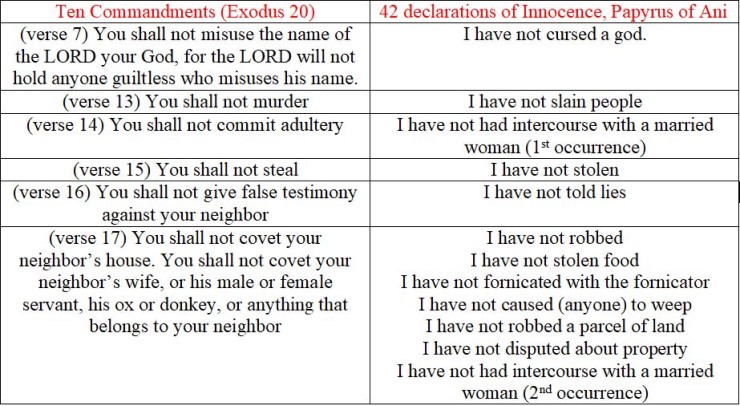

The Great Hymn to the Aten's authorship is attributed to Akhenaten (1353-36 BCE, as per Encyclopædia Britannica, 2012). Here's a comparison of the Biblical Book of Psalm 104 (King James Version) and the Great Hymn to the Aten's translation found in Miriam Lichtheim's "Ancient Egyptian Literature, Volume II: The New Kingdom" (pages 96 to 99).
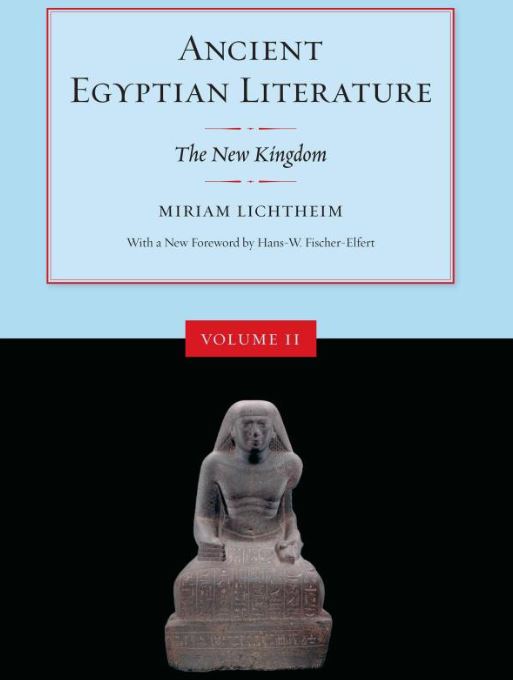
Great Hymn to Aten:
When you set in western light land,
Earth is in darkness as if in death;
Psalm 104 verse 20:
Thou makest darkness, and it is night [...]
Great Hymn to Aten:
Every lion comes from its den
Psalm 104 verse 21:
The young lions roar after their prey [...]
Great Hymn to Aten:
When you shine as Aten of daytime;
As you dispel the dark,
As you cast your rays
Psalm 104 verse 22:
The sun ariseth [...]
Great Hymn to Aten:
The entire land sets out to work
Psalm 104 verse 23:
Man goeth forth unto his work and to his labour until the evening.
Great Hymn to Aten:
Trees, herbs are sprouting
Psalm 104 verse 16:
The trees of the Lord are full of sap [...]
Great Hymn to Aten:
Birds fly from their nests
Psalm 104 verse 12:
By them shall the fowls of the heaven have their habitation, which sing among the branches.
Great Hymn to Aten:
Ships fare north, fare south as well
Psalm 104 verse 26:
There go the ships [...]
Great Hymn to Aten:
Giver of breath,
To nourish all that he made.
Psalm 104 verse 29:
Thou hidest thy face, they are troubled: thou takest away their breath, they die [...]
Great Hymn to Aten:
You supply his needs.
To nourish all that he made.
Psalm 104 verse 28:
That thou givest them they gather: thou openest thine hand, they are filled with good.
Great Hymn to Aten:
How many are your deeds
Psalm 104 verse 24:
O Lord , how manifold are thy works! [...]
Great Hymn to Aten:
You made a heavenly Hapy* descend for them;
He makes waves on the mountains like the sea
*Hapi is the word for "Nile Flood" (Obsomer, "Middle Egyptian" p. 274)
Psalm 104 verse 13:
He watereth the hills from his chambers [...]
Great Hymn to Aten:
You made the seasons to foster all that you made,
Winter to cool them, heat that they taste you.
Psalm 104 verse 19:
He appointed the moon for seasons: the sun knoweth his going down.
The Great Hymn to the Aten's translation found in Miriam Lichtheim's
"Ancient Egyptian Literature, Volume II: The New Kingdom" (pages 96 to 99).
Great Hymn to Aten:
There is no other who knows you,
Only your son, Neferkheprure, Sole-one-of-Re,
Whom you have taught your ways and your might.
Matthew 11:27
No one knows the Son except the Father, and no one knows the Father except the Son and those to whom the Son chooses to reveal him.
Luke 10:22
No one knows who the Son is except the Father, and no one knows who the Father is except the Son and those to whom the Son chooses to reveal him.
The Instruction of Amenemope is a text "probably composed during the late New Kingdom (1300-1075 BCE )" according to the Encyclopædia Britannica. In the book "Ancient Egyptian Literature, Volume II: The New Kingdom" (page 147), Miriam Lichtheim wrote:
It can hardly be doubted that the author of Proverbs was acquainted with the Egyptian work and borrowed from it, for in addition to the similarities in thought and expression—especially close and striking in Proverbs xxii and xxiii—the line in xxii, 20: “Have I not written for you thirty sayings of admonition and knowledge” derives its meaning from the author’s acquaintance with the “thirty” chapters of Amenemope. Ever since Adolf Erman pointed this out there has been a consensus among scholars on a literary relationship, although some scholars have tried to interpret it in reverse by claiming priority for the Hebrew text, or have proposed to derive both works from a lost Semitic original. The Instruction of Amenemope is completely preserved in the British Museum Papyrus 10474.
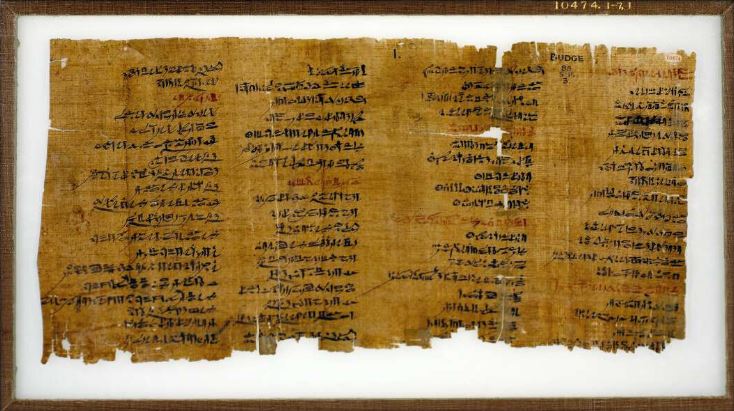
Papyrus of the Teaching of Amenemope, Museum Number
EA10474,1

Screen capture from"Bible Gateway" (see the next link), after verse 16 of Proverbs 22, it says:
"Thirty Sayings of the Wise", the first saying starts at the verse 17
Here's a comparison of the Biblical Book of Proverbs (New International Version) and the Instruction of Amenemope as translated in Lichtheim's "Ancient Egyptian Literature, Volume II: The New Kingdom" (pages 148 to 162):
Instruction of Amenemope (Chapter 1)
Give your ears, hear the sayings
Proverbs 22:17
Pay attention and turn your ear to the sayings of the wise
Instruction of Amenemope (Chapter 1)
Give your heart to understand them;
It profits to put them in your heart
Proverbs 22:17
apply your heart to what I teach
Instruction of Amenemope (Chapter 6)
Do not move the markers on the borders of fields,
Nor shift the position of the measuring-cord.
Do not be greedy for a cubit of land,
Nor encroach on the boundaries of a widow.
Proverbs 23:10
Do not move an ancient boundary stone
or encroach on the fields of the fatherless
Instruction of Amenemope (Chapter 7)
If riches come to you by theft,
They will not stay the night with you.
Comes day they are not in your house,
Their place is seen but they’re not there;
Earth opened its mouth, leveled them, swallowed them,
And made them sink into dat.
They made a hole as big as their size,
And sank into the netherworld;
They made themselves wings like geese,
Proverbs 23:4-5
Do not wear yourself out to get rich;
do not trust your own cleverness.
Cast but a glance at riches, and they are gone,
for they will surely sprout wings
and fly off to the sky like an eagle.
Instruction of Amenemope (Chapter 9)
Do not befriend the heated man,
Nor approach him for conversation.
Proverbs 22:24
Do not make friends with a hot-tempered person,
do not associate with one easily angered
Instruction of Amenemope (Chapter 10)
God hates the falsifier of words,
He greatly abhors the dissembler.
Proverbs 12:22
The Lord detests lying lips,
but he delights in people who are trustworthy.
Instruction of Amenemope (Chapter 11)
Do not covet a poor man’s goods,
Nor hunger for his bread;
A poor man’s goods are a block in the throat,
It makes the gullet vomit.
He who makes gain by lying oaths
Proverbs 22:22
Do not exploit the poor because they are poor
and do not crush the needy in court
Instruction of Amenemope (Chapter 13)
Better is praise with the love of men
Than wealth in the storehouse;
Proverbs 22:1
A good name is more desirable than great riches;
to be esteemed is better than silver or gold.
Instruction of Amenemope (Chapter 17)
Beware of disguising the measure,
[...]
Measure according to its true size,
[...]
Do not make a bushel of twice its size,
[...]
It abhors him who trims;
A measurer who indulges in cheating
Proverbs 20:23
The Lord detests differing weights,
and dishonest scales do not please him.
Instruction of Amenemope (Chapter 21)
Broadcast not your words to others,
Nor join with one who bares his heart.
Better is one whose speech is in his belly
Than he who tells it to cause harm.
Proverbs 20:19
A gossip betrays a confidence;
so avoid anyone who talks too much.
Instruction of Amenemope (Chapter 23)
Do not eat in the presence of an official
And then set your mouth before him ;
If you are sated pretend to chew,
Content yourself with your saliva.
Look at the bowl that is before you,
And let it serve your needs.
Proverbs 23:1
When you sit to dine with a ruler,
note well what is before you,
and put a knife to your throat
if you are given to gluttony.
Do not crave his delicacies,
for that food is deceptive.
Instruction of Amenemope (Chapter 30)
The scribe who is skilled in his office,
He is found worthy to be a courtier.
Proverbs 22:29
Do you see someone skilled in their work?
They will serve before kings;
they will not serve before officials of low rank.
Ptah-Hotep's wisdom, also known as "The Maxims of Ptah-Hotep" and "The Instruction of Ptah-Hotep" is a text written by the ancient Egyptian vizier named Ptah-Hotep (circa 2400 BCE) during the rule of king Djedkare Isesi.

Ptah-Hotep (Encyclopædia Britannica)
In "The Wisdom of Ptah-Hotep" by Christian Jacq, the author wrote:
"Jéquier, along with Dévaud, who considered The Wisdom of Ptah-Hotep to be
the 'the oldest book in the world' [...]" (introduction - xiv -)
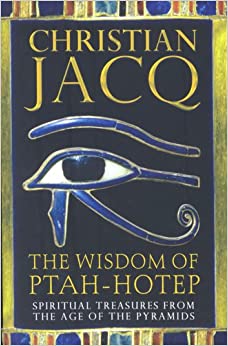
In "Ancient Egyptian Literature, Volume I: The Old and Middle Kingdoms" (page 61),
Miriam Lichtheim wrote:
This long work has survived in four copies, three of which are written on papyrus rolls while the fourth, containing only the beginning, is on a wooden tablet.
The only complete version is that of Papyrus Prisse of the Bibliothèque Nationale, which dates from the Middle Kingdom. The other two papyri, both in the British Museum, are from the Middle and New Kingdoms, respectively. The wooden tablet, Carnarvon Tablet I in the Cairo Museum, also dates from the New Kingdom. The version of P. Prisse differs considerably from that of the other three copies. The
translation here given reproduces the text of P. Prisse only. The work consists of thirty-seven maxims framed by a prologue and an epilogue.
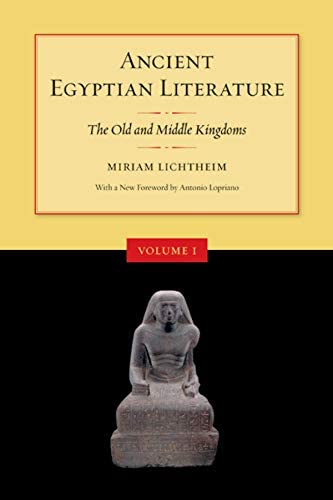
Here's a comparison of the Biblical Book of Proverbs (NIV) and "The Wisdom of Ptah-Hotep" as translated in Lichtheim's "Ancient Egyptian Literature, Vol. I: The Old and Middle Kingdoms" (pp. 62- 76)
Ptah-Hotep wisdom (Maxim 1)
Don't be proud of your knowledge,
Consult the ignorant and the wise
Proverbs 1:5
let the wise listen and add to their learning,
and let the discerning get guidance
Ptah-Hotep wisdom (Maxim 3)
If you meet a disputant in action
Who is your equal, on your level,
You will make your worth exceed by silence
Proverbs 17:14
Starting a quarrel is like breaching a dam;
so drop the matter before a dispute breaks out.
Ptah-Hotep wisdom (Maxim 7)
If you are one among guests
At the table of one greater than you,
Take what he gives as it is set before you;
Look at what is before you
Proverbs 23:1
When you sit to dine with a ruler,
note well what is before you,
Ptah-Hotep wisdom (Maxim 9)
Do not boast at your neighbors' side,
One has great respect for the silent man
Proverbs 17:28
Even fools are thought wise if they keep silent,
and discerning if they hold their tongues.
Amenhotep son of Hapu: "A necklace of pure gold and all kind of material was put around his neck"
Genesis ch. 41 v. 42: "and put a gold chain about his neck"
Amenhotep son of Hapu: "His body was dressed with delicate fabric and first quality linen..."
Genesis ch. 41 v. 42: "and arrayed him in vestures of fine linen"
A report of excavations was published by the French Institute in Cairo (Institut Français du Caire) under the direction of M. P. JOUGUET. This institute was under the French Ministry (Department) of National Education (Minstère de l'Éducation Nationale).
Here we have "part 11" (TOME XI) of the excavations in the Temple of the Royal Scribe AMENHOTEP, son of HAPU (Le Temple du Scribe Royal AMENHOTEP, fils de HAPU) by Clément Robichon and Alexandre Varille, Volume I (1936). This report is hosted on the website of the French national library (Bibliothèque nationale de France): https://gallica.bnf.fr/ark:/12148/bpt6k853167p
A download link is also provided in the menu located on the right hand side, you can click on the "download" icon:

On page 148 of the PDF, there is a picture showing fragments of a mural painting of the "third right lateral chapel" (Fragments de peinture murale de la troisième chapelle latérale droite). On the top right hand corner, it says "Plate 35" (Pl. XXXV.):
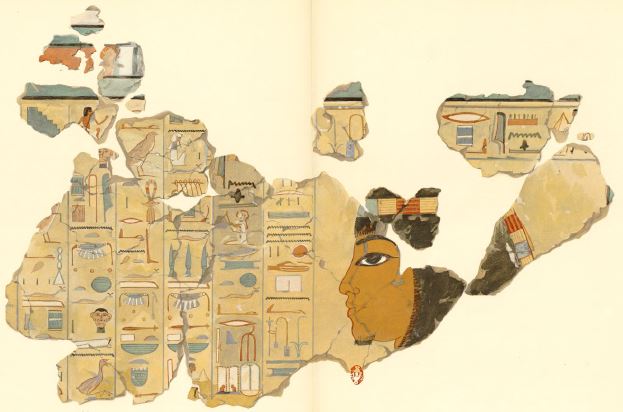
Alexandre Varille provided the hieroglyphic transcript and a translation in his "Inscriptions concerning the architect Amenhotep son of Hapu" (Inscriptions conernant l'architecte Amenhotep fils de Hapou) in the publication referenced "Library of Study, T. 44" (Bibliothèque d'Étude, T. XLIV) of the French Institute of Oriental Archaeology, printed in 1968. It is available on the Internet Archive website: https://archive.org/details/BdE-44

On Chapter 3 "Inscriptions of the funerary temple of Amenhotep" (CHAPITRE III. Inscriptions du Temple Funéraire d'Amenhotep), page 90 (PDF page 56), there is part D. - JUBILEE REWARDS (D. - RÉCOMPENSES JUBILAIRES.) with a drawing (by M. Jacquemin) of the wall painting labelled "figure 14 (FIG. 14):
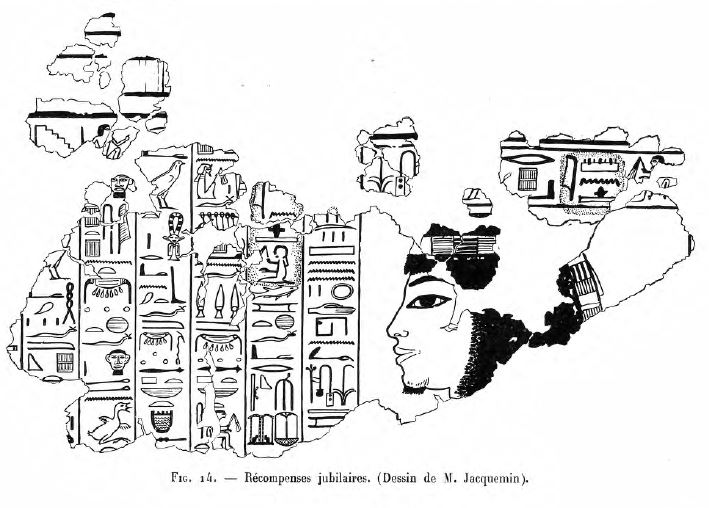
We are informed that this group of fragments carry the number A. 1208 of their excavation's inventory (Ce groupe de fragments porte le numéro A. 1208 de notre inventaire de fouille). Then on the next page (91) the hieroglyphic transcript is presented in six columns, under the reference "Text N° 30" (TEXTE N° 30. Inscription en six colonnes):

On the following page (92), we have the translation (in French):
1 An XXX, troisième mois de l'Été, deuxième jour. Le juste scribe du roi qui l'aime 2 Amenhotep, creuseur de canaux, s'est incliné (devant le souverain) à l'issue de la célébration 3 du premier jubilé de Sa Majesté. Il a reçu des ornements en or et en toutes sortes de matières précieuses. 4 Un collier en or pur et en toutes sortes de matières a été passé à son cou. Il s'est assis 5 sur un carreau doré en face de l'estrade 6 (royale). Son corps a été habillé d'étoffe délicate et de lin de première qualité...

In English, that gives us:
1 Year XXX, third month of summer, second day. The just scribe of the king who loves him 2 Amenhotep, canal digger, bowed (in front of the sovereign) at the end of the celebration 3 of the first jubilee of His Majesty. He received ornaments in gold and all kind of precious material. 4 A necklace of pure gold and all kind of material was put around his neck. He sat 5 on a golden square in front of the (royal) platform 6. His body was dressed with delicate fabric and first quality linen...
Now let us compare the last part of this translation with the Bible in the book of Genesis chapter 41 verse 42:
"And Pharaoh took off his ring from his hand, and put it upon Joseph's hand, and arrayed him in vestures of fine linen, and put a gold chain about his neck" (Bible Gateway, King James Version).

Amenhotep son of Hapu: "A necklace of pure gold and all kind of material was put around his neck"
Genesis ch. 41 v. 42: "and put a gold chain about his neck"
Amenhotep son of Hapu: "His body was dressed with delicate fabric and first quality linen..."
Genesis ch. 41 v. 42: "and arrayed him in vestures of fine linen"
Book of the Heavenly Cow: "I am who I am" (Tomb of Seti I)
Exodus 3:14: "I am who I am"
Eugène Lefébure published hieroglyphic transcripts from the Tomb of Seti I (KV17) with the collaboration of Urbain Bouriant, Victor Loret and Édouard Naville in a publication by the French Archaeological Mission in Cairo 1882-1884, Second Volume, The Royal Hypogeum of Thebes (Mission Archéologique Française au Caire 1882-1884, Tome Second, Les Hypogées Royaux de Thèbes) under the Ministry (Department) of Public Instruction and Fine Arts (Ministère de l'Instruction Publique et des Beaux-Arts). This report is hosted on the website of the French national library (Bibliothèque nationale de France): https://gallica.bnf.fr/ark:/12148/bpt6k5110719
A download link is also provided in the menu located on the right hand side, you can click on the "download" icon:


On page 140 of the PDF, we have plate 16 (PL. XVI). On the culumn 49 (the numbering is at the bottom) the text of interest begins from the 8th glyph starting from the top, which is the reed leaf (Gardiner reference M17) followed by the quail chick (Gardiner reference G43), then a seated man (Gardiner reference A1) and right after we have another reed leaf, an owl (Gardiner reference G17) then a seated man.
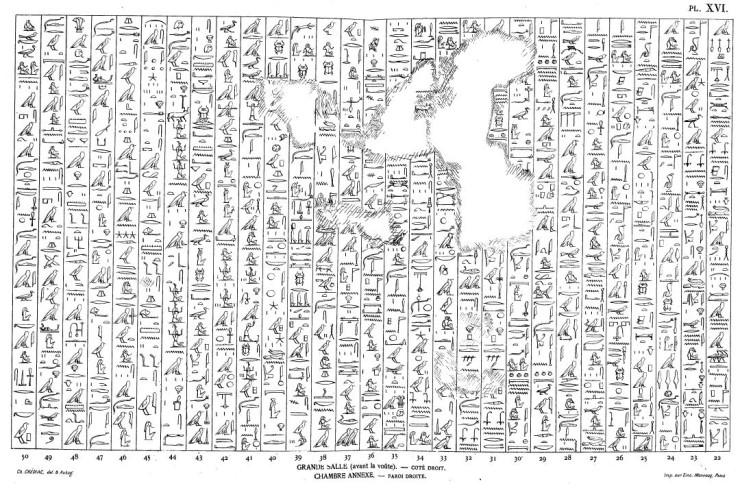
The phonetic value for the reed leaf is the sound "ee" transliterated with the letter "i" or "j".
The phonetic value for the quail chick is the sound "oo" transliterated with the letter "w".
The phonetic value for the owl is the sound "m" transliterated with the letter "m".
The transliteration of the passage is therefore: iw.i im.i.
The combination "iw.i" means "I am", the seated man serves as the 1st singular person suffix pronoun:
"Egyptian Grammar" by Alan Gardiner page 247

"Hieroglyphic Egyptian" by Claude Obsomer, page 151

"Middle Egyptian" by James P. Allen, page 281

"Egyptian Grammar" by Alan Gardiner, page 550

The combination "im" can have several meaning, Faulkner gives us the following definition:
"there", "therein", "therewith", "therefrom". Gardiner has similar vocabulary:
"A Concise Dictionary of Middle Egyptian" by Raymond O. Faulkner, page 17

"Egyptian Grammar" by Alan Gardiner, page 553

But in certain cases, some construction will give "im" different translations, knowing that from one language to another we can not always translate word for word. For instance, James P. Allen translated "bw ntj ntrw jm" as follows: "the place in which the gods are".
"Middle Egyptian" by James P. Allen, page 353

On the next page, James P. Allen translated "bw ntj.f jm" as follows: "the place that he is in",
later on the same page, Allen translated "`t tn ntt wi im.s" as "this room that I am in".
"Middle Egyptian" by James P. Allen, page 354

"Middle Egyptian" by James P. Allen, page 354

So the text "iw.i im.i" from the tomb of Seti I was translated as "I am who I am" by the Egyptologist Edward F. Wente on page 294 of the book "The Literature of Ancient Egypt An Anthology of Stories, Instructions, Stelae, Autobiographies, and Poetry" edited by William Kelley Simpson with translations by Robert K. Ritner, Vincent A. Tobin, Edward F. Wente, Jr. (2003, Yale University Press).
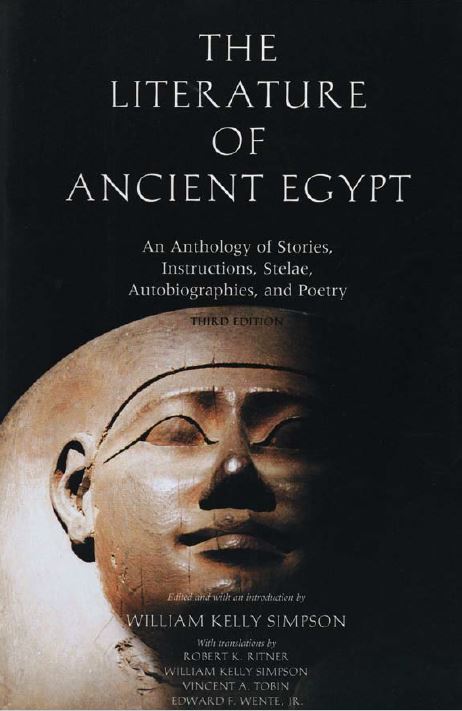
Hieroglyphic transcript of "iw.i im.i" in the tomb of Seti I (see references above)
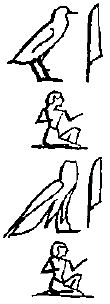
"iw.i im.i" translated as "I am who I am" by Edward F. Wente

In the Bible, book of Exodus chapter 3 verse 14 (Moses and the Burning Bush), it says:
God said to Moses, “I am who I am. This is what you are to say to the Israelites: ‘I am has sent me to you.’” (Bible Gateway, New International Version).
A footnote after "I am who I am" informs us: "Or I will be what I will be".

Once we click on Exodus 3:14 in all English translations,
we have the translation "I am who I am" 38 times,
we have the translation "I am that I am" 11 times.
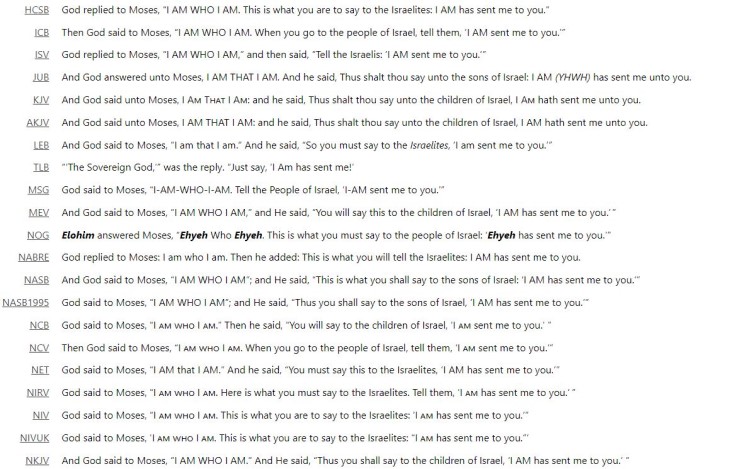


"A Hymn to Atum was recovered by British archaeologists in 1865 and is preserved today in the British Museum (London). The original hymn was composed between 1307 and 1070 BCE; this copy (Papyrus Bremner-Rhind, BM 10188) was made between 300 and 275 BCE and buried with the priest Nes-Min at Luxor."
Old Testament Parallels: Laws and Stories from the Ancient Near East (Fully Revised and Expanded Fourth Edition) by Victor H. Matthews and Don C. Benjamin (p. 25). Paulist Press. Kindle edition.
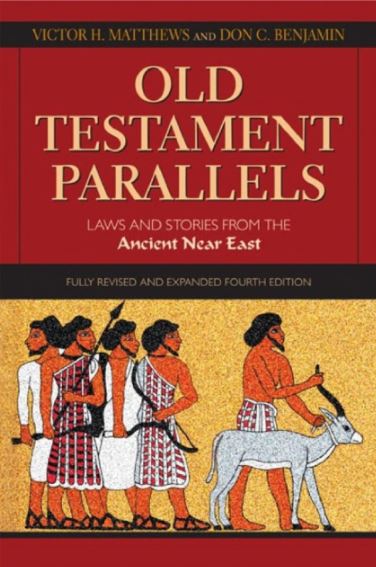
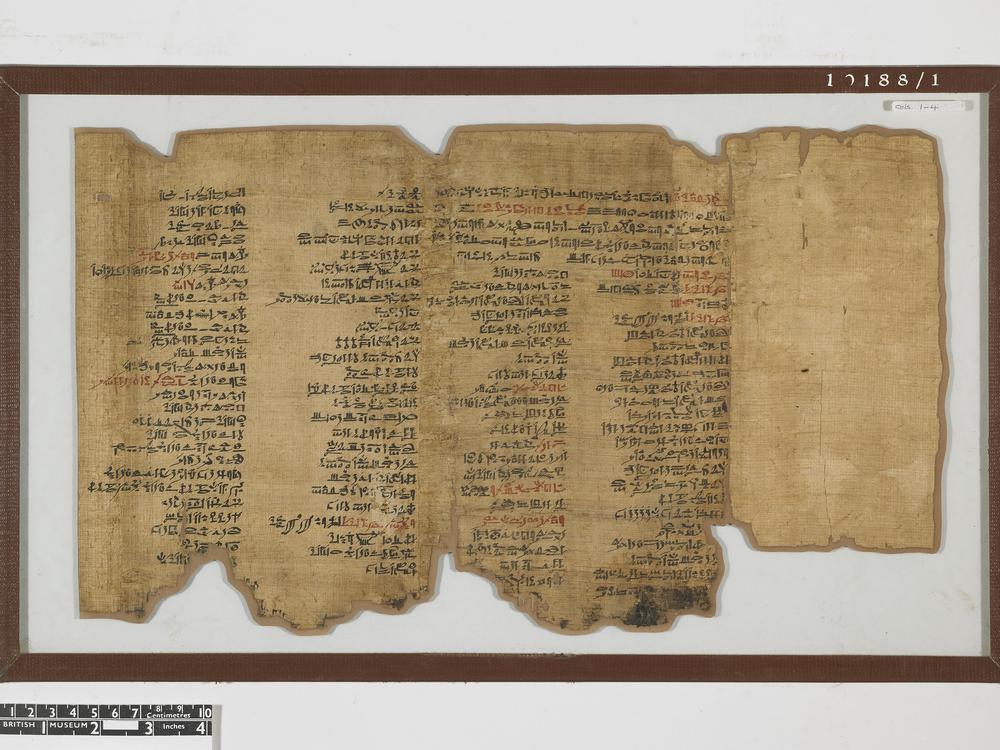
Papyrus Bremner-Rhind, BM 10188 (source: British Museum)
Cols xxvi: 21– xxvii: 5 (page 26)
Papyrus Bremner-Rhind
There were no heavens and no earth
Genesis 1:1 (KJV)
In the beginning God created the heaven and the earth.
Papyrus Bremner-Rhind
When the almighty speaks, all else comes to life.
Genesis 1:3 (KJV)
And God said, Let there be light: and there was light.
Papyrus Bremner-Rhind
There was no dry land
Genesis 1:9 (KJV)
And God said, Let the waters under the heaven be gathered together unto one place,
and let the dry land appear: and it was so.
Papyrus Bremner-Rhind
There were no reptiles, worms or insects in the land (page 26)
I created reptiles, worms and insects. (page 27)
Genesis 1:24-25 (KJV)
And God said, Let the earth bring forth the living creature after his kind, cattle, and creeping thing, and beast of the earth after his kind: and it was so.
And God made the beast of the earth after his kind, and cattle after their kind, and every thing that creepeth upon the earth after his kind: and God saw that it was good.
Papyrus Bremner-Rhind
These nine [Greek: ennead] gave birth to everything on earth. (page 28)
Genesis 1:28 (KJV)
And God blessed them, and God said unto them, Be fruitful, and multiply, and replenish the earth, and subdue it: and have dominion over the fish of the sea, and over the fowl of the air, and over every living thing that moveth upon the earth.
A Hymn to Ptah on the Shabaka Stela at Memphis dates back to 1307– 1196 BCE. This copy, commissioned by Pharaoh Shabaka (719– 703 BCE), was recovered by British archaeologists in the 1830s. Breaks left in the text reflect missing portions in the original. It is written in an archaic style similar to the Pyramid Texts and is preserved today in the British Museum in London (BM 498).
Old Testament Parallels: Laws and Stories from the Ancient Near East (Fully Revised and Expanded Fourth Edition) by Victor H. Matthews and Don C. Benjamin (p. 29).
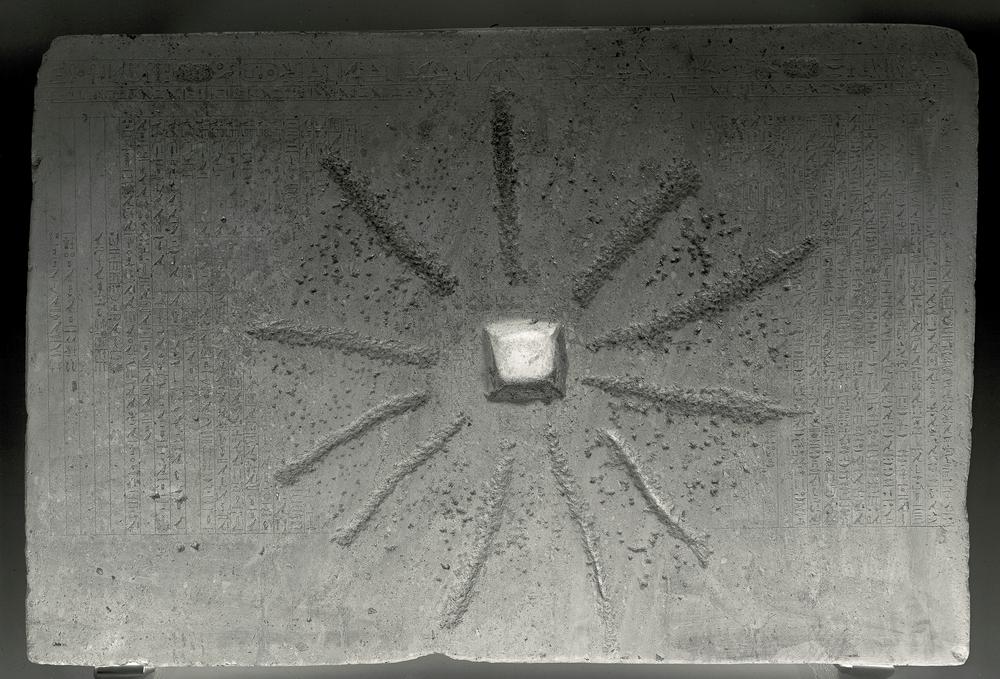
Shabako Stone [EA498]
(source: British Museum)
Shabako Stone
Ptah— first to rise from the sacred mound— gave birth to the Ennead and all good things. Ptah fathered the divine household. When all these things were done, Ptah rested. (page 34)
Genesis 2:2 (KJV)
And on the seventh day God ended his work which he had made; and he rested on the seventh day from all his work which he had made.
Hatshepsut Annals
In 1894, Edouard Naville discovered the Annals of Hatshepsut on the walls of Deir el-Bahari, her funeral temple in the Valley of the Pharaohs. Another copy of her annals is inscribed on an arch in the House of Pakhet that she and Tuthmosis III built at Speos Artemidos [Arabic: Istabl Antar] in the eastern desert near Beni Hasan.
Old Testament Parallels: Laws and Stories from the Ancient Near East (Fully Revised and Expanded Fourth Edition) by Victor H. Matthews and Don C. Benjamin (p. 112).
The inscriptions of Hatshepsut at Deir el-Bahari are badly damaged. Restorations are based on a parallel inscription of Amenophis III (1391– 1353 BCE) at Luxor. (p.114)
Hatshepsut Annals
I, Khnum, say to Hatshepsut, The divine potter says to the child of Amun-Re: ‘I have created you from the divine patron of Karnak. (page 116)
Isaiah 64:8 (KJV)
But now, O Lord , thou art our father; we are the clay, and thou our potter; and we all are the work of thy hand.
Papyrus D'Orbiney (Tale of Two Brothers) circa 1215 bce
In 1852, Emmanuel de Rougé, a French scholar, published the first translation of the Stories of Anubis and Bata, as they were being told during the Nineteenth Dynasty (1307– 1196 BCE). The stories were written on papyrus, not in formal hieroglyphic characters, but in hieratic or cursive style of writing, used principally in business documents. The P. D’Orbiney manuscript is preserved today in the British Museum in London (EA 10183).
Old Testament Parallels: Laws and Stories from the Ancient Near East (Fully Revised and Expanded Fourth Edition) by Victor H. Matthews and Don C. Benjamin (p. 120).
"The episode of Bata and his brother’s wife has a remarkable similarity with the tale of Joseph and Potiphar’s wife, a similarity that has often been commented on."
Miriam Lichtheim's "Ancient Egyptian Literature, Volume II: The New Kingdom" (page 203).

D'Orbiney Papyrus [EA10183] (source: British Museum)
Joyce Tyldesley "Judgement of the Pharaoh" (pp. 158-59)
Anubis and Bata were two brothers. Anubis, the elder, had a house and a wife. His younger brother lived with him, and was treated as a son. Bata worked for his brother, tending the cattle, ploughing the fields and harvesting the grain. He was a fine, vigorous young man.
One day the brothers were in the field. Anubis asked his
brother to return to the house to collect some seed. Bata went, and found his brother's wife dressing her hair. The wife watched the strong young man hoist the grain onto his shoulders, and was impressed with his strength. She desired him, and spoke, 'Come, let us spend an hour together. And afterwards I will make you some new clothes.
Bata was shocked by this proposal. Look, I regard you as a mother and my brother as a father. What a terrible thing you have said. Do not mention this again and I will tell no one what has happened.' Bata then picked up his burden and returned to the field.
The woman, left alone in the house, grew frightened, imagining that Bata would tell his brother what had happened. She decided to tell her side of the story first. Taking her cosmetics, she made herself up to look as if she had been beaten. Then she lay down, pretending to be sick. When her husband returned she did not get up to greet him, and she did not light the lamp. The house was in darkness, and peering through the gloom Anubis found his wife vomiting. When Anubis questioned her, she accused Bata of attempted seduction: Your brother said, "Come let us sleep together for an hour, but I would not listen to him and he beat me so that I would not tell you.
Genesis 39:1-18 (KJV)
And Joseph was brought down to Egypt; and Potiphar, an officer of Pharaoh, captain of the guard, an Egyptian, bought him of the hands of the Ishmeelites, which had brought him down thither.
And the Lord was with Joseph, and he was a prosperous man; and he was in the house of his master the Egyptian.
And his master saw that the Lord was with him, and that the Lord made all that he did to prosper in his hand.
And Joseph found grace in his sight, and he served him: and he made him overseer over his house, and all that he had he put into his hand.
And it came to pass from the time that he had made him overseer in his house, and over all that he had, that the Lord blessed the Egyptian's house for Joseph's sake; and the blessing of the Lord was upon all that he had in the house, and in the field.
And he left all that he had in Joseph's hand; and he knew not ought he had, save the bread which he did eat. And Joseph was a goodly person, and well favoured.
And it came to pass after these things, that his master's wife cast her eyes upon Joseph; and she said, Lie with me.
But he refused, and said unto his master's wife, Behold, my master wotteth not what is with me in the house, and he hath committed all that he hath to my hand;
There is none greater in this house than I; neither hath he kept back any thing from me but thee, because thou art his wife: how then can I do this great wickedness, and sin against God?
And it came to pass, as she spake to Joseph day by day, that he hearkened not unto her, to lie by her, or to be with her.
And it came to pass about this time, that Joseph went into the house to do his business; and there was none of the men of the house there within.
And she caught him by his garment, saying, Lie with me: and he left his garment in her hand, and fled, and got him out.
And it came to pass, when she saw that he had left his garment in her hand, and was fled forth,
That she called unto the men of her house, and spake unto them, saying, See, he hath brought in an Hebrew unto us to mock us; he came in unto me to lie with me, and I cried with a loud voice:
And it came to pass, when he heard that I lifted up my voice and cried, that he left his garment with me, and fled, and got him out.
And she laid up his garment by her, until his lord came home.
And she spake unto him according to these words, saying, The Hebrew servant, which thou hast brought unto us, came in unto me to mock me:
And it came to pass, as I lifted up my voice and cried, that he left his garment with me, and fled out.
Fire as punishment: Seti I, Jesus & Revelation
In Miriam Lichtheim's "Ancient Egyptian Literature, Volume II: The New Kingdom" page 56, we are told about the 'Dedication Inscription of Seti I' (circa 1290–1279 BCE as per Encyclopædia Britannica 2012):
Dedication Inscription of Seti I
But as to any official who, in the manner of an evil witness, shall
suggest to his lord to remove the workmen and place them in another
service, he is destined for the fire that shall burn his body, for the
flame that shall consume his limbs! For his majesty has done all this
for the ka's of the lords of my House! God abhors him who interferes
with his people. He does not fail to thwart the despoiler.
Matthew 9:43 (Jesus)
And if thy hand offend thee, cut it off: it is better for thee to enter into life maimed, than having two hands to go into hell, into the fire that never shall be quenched
Matthew 13:40-42 (Jesus)
As the weeds are pulled up and burned in the fire, so it will be at the end of the age. The Son of Man will send out his angels, and they will weed out of his kingdom everything that causes sin and all who do evil. They will throw them into the blazing furnace, where there will be weeping and gnashing of teeth.
Matthew 25:41 (Jesus)
Then shall he say also unto them on the left hand, Depart from me,
ye cursed, into everlasting fire, prepared for the devil and his angels
Revelation 21:8
But the fearful, and unbelieving, and the abominable, and murderers, and whoremongers, and sorcerers, and idolaters, and all liars, shall have their part in the lake which burneth with fire and brimstone: which is the second death.
Lake of Fire: Papyrus of Ani & Revelation 20
The Bible has several passages with the "Lake of Fire". Besides mentions of the Greek god Hades, "Lake of Fire" is repeated between verses 11 and 15 of the Book of Revelation chapter 20. Here is the NIV translation of the part called "The Judgment of the Dead" by The Bible Gateway:
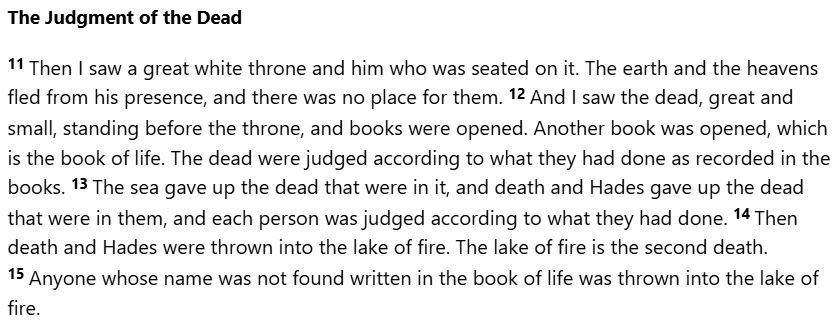
Revelation 20:15
Anyone whose name was not found written in the book of life was thrown into the lake of fire.
Richard H. Wilkinson mentioned "Lake of Fire" several times in his book "Reading Egyptian Art"

while describing the Papyrus of Ani on page 72, the Papyrus of Neskhonsu
on page 136, and also the
Papyrus of Bakenmut on page 160:



Furthermore, he stressed the similarity with Christianity on page 161:
"Beyond this solar imagery, fire was also an important element in the Egyptian concept of the underworld, often in ways strikingly similar to the medieval Christian conception of hell."
Dr. Ogden Goelet stated that the "Lake of Fire" is mentioned frequently in the "Book of the Dead" on page 178 of the aforementioned book:
The scene shows four cynocephalous baboons sitting at the corners of a rectangular pool. On each side of this pool is a flaming brazier. The pool's red color indicates that it is filled with a fiery liquid, reminding one of the "Lake of Fire" frequently mentioned in the BD. (Nota bene: on page 149 of the same chapter, the author informs us that "BD" stands for "Book of the Dead")
Genesis 6 & Book of coming forth by day (chapter 175)
“Book of the Dead” is one of the world’s most famous misnomer, it was coined by Karl Richard Lepsius in 1842 with the german term
Todtenbuch (modern spelling Totenbuch). The common expression Pert Em Heru (or Peret Em Heru) derives from the transliteration rw nw prt m hrw which can be translated as “Spells of coming forth in the daytime”, a more appropriate and accurate appellation.

Raymond Oliver Faulkner's translation was used in the book "The Ancient Egyptian Book of the Dead", edited by Carol Andrews (revised edition 1985, first published 1972). On page 175 (Spell 175) during a conversation between the gods Thoth (Djehuty) and Atum, it is asked to shorten the years of wrongdoers:
You shall not witness wrong-doing, you shall not suffer it!
Shorten their years, cut short their months,
because they have done hidden damage to all that you have made.

In the Bible book of Genesis chapter 6 (NIV), verses 1 to 3 it says:
When human beings began to increase in number on the earth and daughters were born to them, the sons of God saw that the daughters of humans were beautiful, and they married any of them they chose. Then the Lord said, “My Spirit will not contend with humans forever, for they are mortal; their days will be a hundred and twenty years.”

Therefore in the Biblical text as well, God decides to shorten the years of people. As for the motive, a clue is given in the footnote [b] right after the word mortal. Here is the screen capture of New International Version translation on the website Bible Gateway, it says "or corrupt":

So the reason for the god of the Bible's choice to shorten the years of people seems to be because they are wrongdoers.
Noah and the Flood compared with the Papyrus of Ani
In the Book of Genesis chapter 6, there is a part called "Noah and the Flood" on the Bible Gateway. On verse 17 it says:
I am going to bring floodwaters on the earth to destroy all life under the heavens, every creature that has the breath of life in it. Everything on earth will perish.

In "The Ancient Egyptian Book of the Dead" edited by Carol Andrews page 175 (Spell 175), Faulkner's translation says:
ATUM: I will despatch the Elders and destroy all that I have made; the earth shall return to the Abyss, to the surging flood, as in its original state.

Faulkner's translation differs with two words in "Egyptian Book of the Dead: The Book of Going Forth by Day: The Complete Papyrus of Ani Featuring Integrated Text and Full-Color Images" on chapter 125, Plate 29-B; instead of "Abyss" it says "Primordial Water":
ATUM: I will despatch the Elders and destroy all that I have made; the earth shall return to the Primordial Water, to the surging flood, as in its original state.

King of Kings and Lord of Lords
In the Papyrus of Ani (British Museum reference EA 10470), it says "King of Kings and Lord of Lords", this sentence is found also in the Biblical book of Revelations. First we have Wallis Budge's translation taken from his book "The Book of the Dead: The Hieroglyphic Transcript and Translation into English of the Ancient Egyptian Papyrus of Ani" page 352


Secondly, we have Raymond Faulkner's translation in the book "The Egyptian Book of the Dead: The Book of Going Forth by DayThe Complete Papyrus of Ani Featuring Integrated Text and Full-Color" on page PLATE 2-B


Faulkner's translation is also in the book edited by Carol Andrews entitled "The Ancient Egyptian Book of the Dead" on page 27

As for the Bible, in Revelation chapter 19 verse 16 it also says "King of Kings, Lord of Lords"

In Revelation chapter 17 verse 14 it says "Lord of Lords, and King of Kings"

The last shall be the first
This sentence is found in the Biblical book of Matthews chapter 20, verse 16:

Way before the Bible Gospels, there was an instruction from Kemet known as "The Teaching of a Man for his Son" where it says "the one in last place to become first" as translated by Stephen Quirke in his book "Egyptian Literature 1800BC : Questions and Readings" page 102:

The main sources for are listed on this page of The Petrie Museum website, hosted on the University College London:
Fragments of hieratic papyri of Dynasty 18:
Papyrus Berlin 15733 b-f
Papyrus Berlin 15738 a, c, f, g
Papyrus (Pierpont Morgan) Amherst XV
Papyrus Turin 54016
Papyrus Turin 54017
Hieratic on leather roll of Dynasty 18:
British Museum ESA 10258
Hieratic ostraca, Ramesside Period:
UC 6484 (Fischer-Elfert source 140)
UC 31954 (Fischer-Elfert source 141)
UC 31995 (Ostracon Petrie 52, Fischer-Elfert source 55)
UC 31999 (Ostracon Petrie 69, Fischer-Elfert source 56)
UC 32945 (this item from the Ramesseum, Fischer-Elfert source 150)
Papyrus fragments of the New Kingdom:
Papyrus Berlin 15742
Papyrus Clere I
Papyrus Louvre N 3171
Hieratic writing-board of the New Kingdom:
Turin CG 58006
Hieratic ostraca of the New Kingdom, in addition to those in the Petrie Museum cited above: 137 other ostraca, full list in Fischer-Elfert 1999, vol. II, x-xxv
Psalm 23 & Hymn to Amun
The Bible book of Psalm, attributed to king David, says on chapter 23:
"The Lord is my shepherd" & "
He makes me lie down in green pastures" :

In the British Museum, there is an ostracon, with a
hymn to Amun
on the verso, reference
EA29559 (fomerly numbered 5656a) where it says:
"You are the sheperd Amon, you lead the flock to fresh pastures."

The British Museum has dated this artifact from the 19th Dynasty or the 20th Dynasty (circa 1292-c. 1191 BCE or circa 1190-c. 1077 BCE according to Encyclopædia Britannica). While David is said to have flourished circa 1000 BCE according to the same source. Wikipedia says that
David reigned between the 10th and the 9th century BCE
. Therefore, it is safe to consider that the African artifact found in Thebes (Waset) predates King David...
The Ostracon's translation it taken from Dr. Christian Jacq's book called "The Living Wisdom of Ancient Egypt" on page 66:


Nota Bene; there was a typographical error on page 66 (1999) with the British Museum reference where it says "565 a"). But in the original French book "La Sagesse vivante de l'Égypte ancienne" on page 64 (1998) it does indeed say "5656a".


Alpha & Omega; the beginning and the end
In the Bible, Jesus said he is "the alpha and omega, the beginning and the end, the first and the last" in Revelation 22:13.
In Revelation 21:6, Jesus said he is "alpha and omega, the beginning and the end".
In Revelation 1:8, Jesus said he is "the alpha and omega,
the beginning and the ending".
In the book of Isaiah 44:6, God (the Lord the King of Israel) says "I am the first and I am the last".

In the book "Ancient Egypt Investigated: 101 Important Questions and Intriguing Answers", we are told about a First
Intermediate Period provincial governor who boasted “I am the beginning and
the end of mankind!”.


It is in chapter 3, question 28 "What was the most decisive turning point in Egyptian history?" and page 96 of my eBook.
I emailed the author, Dr. Thomas Schneider (Professor of Egyptology and Near Eastern Studies
at The University of British Columbia) on July 25, 2025 to ask him the name of the governor and the text with the citation and he kindly replied on the same day (thank you once again), informing me that the quote is from the biography of Ankhtifi, Governor of Moalla. He lived 2000 years before Jesus (c. 2118–c. 2080)
Dr. Schneider directed me to a translation on page 86 of of Miriam Lichtheim's "Ancient Egyptian Literature: Volume I: The Old and Middle Kingdoms" saying "I am the vanguard of men and the rearguard of men".



On the previous page (85), Miriam Lichtheim told the readers about the publication of Jacques Vandier entitled "Mo'Alla: La Tombe d'Ankhtifi et La Tombe de Sébekhotep"


On page 171 of Vandier's publication about the tomb of Ankhtifi, we have the hieroglyphic transcript and translation of inscription number 3 "Éloge personnel" (personal eulogy):

It says "J'étais l'avant-garde des hommes (a) et l'arrière-garde des hommes" (I was the vanguard of men and the rearguard of men). Then on pages 171-172, the author's notes say the following (partial translation from French to English):
h3t rmt. These words remind us, first of all, of expressions such as (Hat-Noub) [...] in which h3t corresponds approximately to our word "the first" [...] But in this case, that meaning raises a difficulty: in vertue of the principle of opposition, dear to the Egyptians, the expression phwj rmt should mean, indeed, the last of men. However, if it is legitimate to admit that the nomarch says he is "the first of men", it is a lot less likely that he proclaims himself "the last of men". What meaning should we then give to phwj? Only two can be suitable : phwj can first mean "the end", and h3t, in this hypothesis, should be translated as "the beginning"; to be at the same time the beginning of men and their end is like saying that we are the principle and the end of their activity, or rather (litt. "if we prefer"), that we are the alpha and the omega.


Finally, let me show you those two words, h3t & phwj, translated as "beginning" and "end" not only in the same book (the oldest in the world) but also on the same sentence, found in the closing of the instruction or "Maxims of Ptah-Hotep".
Here are the pictures of the books of Christian Jacq, first the original french work "Les Maximes de Ptah-Hotep" page 217 then the english translation "The Wisdom of Ptah-Hotep" page 155:




Creator of heaven and earth
In the Bible's first chapter and verse, it says "God created the heaven and the earth" in the book of Genesis 1:1 (KJV). The Egyptian god Osiris created "the heaven and the earth" as told in the
Stèle de Ptahmès (inventory number
H 1376) housed in the Musée des Beaux-Arts de Lyon (Lyon Museum of Fine Arts) estimated to be during the lifetime Amenhotep III (circa 1300 BCE according to Britannica).
Alexandre Varille translated this artifact in the BIFAO 30 and on page 504 it says "qui a créé le ciel, qui a créé la terre" (who created the sky, who created the earth):


Line 1 of the Stela of Ptahmose